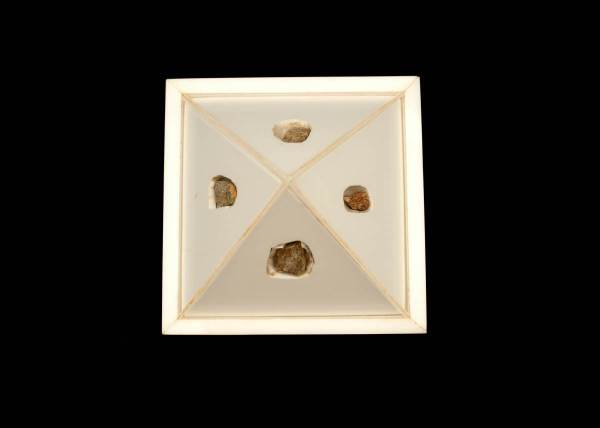Four Holy Relics of Lord Buddha are being taken to Mongolia for an 11-day exposition to coincide with Mongolian Budhha Purnima celebrations. A 25-member delegation, led by Union Law Minister Kiren Rijiju, will accompany the relics on their onward journey on Monday, to be displayed at the Batsagaan Temple in Gandan Monastery complex in Ulaanbaatar.

The site was discovered in 1898.
The sacred relics
At the age of 80, according to Buddhist beliefs, Buddha attained salvation in Uttar Pradesh’s Kushinagar district. The Mallas of Kushinagar cremated his body with ceremonies befitting a universal king. His relics from the funeral pyre were collected and divided into eight shares to be distributed among the Ajathsatrus of Magadha, the Licchavis of Vaishali, the Sakyas of Kapilavastu, Mallas of Kushinagar, Bullies of Allakappa, the Mallas of Pava, the Koliyas of Ramagrama and a Brahmana of Vethadipa. The purpose was erecting stupas over the sacred relics. Two more stupas came up — one over the urn in which the relics had been collected and the other over the embers.
Stupas erected over the bodily relics of Buddha (Saririka stupas) are the earliest surviving Buddhist shrines. It is said that Ashoka (272–232 BC), being an ardent follower of Buddhism, opened up seven of these eight stupas, and collected major portion of the relics for enshrinement within 84,000 stupas built by him in an effort to popularise Buddhism as well as the cult of the stupas.
The Kapilavastu relics
The discovery of an inscribed casket in 1898 at the stupa site in Piprahwa (near UP’s Siddharthnagar) helped identify the place with the ancient Kapilavastu. The inscription on the casket’s lid which refers to the relics of Buddha and his community, the Sakya, reads: ‘Sukiti bhatinam sa-bhaginikanam sa-puta-dalanam iyam salila nidhare Bhaddhasa bhagavate sakiyanam.’
 Top view of the Holy Buddha Relics of 4th – 5th century BC, Piprahwa (Ancient Kapilavastu) District, Siddharth Nagar, Uttar Pradesh. (Photo: National Museum, New Delhi)
Top view of the Holy Buddha Relics of 4th – 5th century BC, Piprahwa (Ancient Kapilavastu) District, Siddharth Nagar, Uttar Pradesh. (Photo: National Museum, New Delhi)
It roughly translates to: “This shrine for relics of the Buddha, the August One, is that of the Sakyas. The brethren of the distinguished One, in association with their sisters and with their children and their wives.”
According to records with the Ministry of Culture, this discovery was followed by many explorations. A further excavation of the stupa by the Archaeological Survey of India in 1971-77 — apart from revealing three stages of the construction — brought to light two more steatite relic caskets, containing a total of 22 sacred bone relics, which are now under the care of the National Museum.
Story continues below this ad
Newsletter | Click to get the day’s best explainers in your inbox
This was followed by the discovery of more than 40 terracotta sealings from different levels and spots in the eastern monastery at Piprahwa saying, ‘Om Devaputra Vihare Kapilavastusa Bhikshu Sanghasa’, which means “community of Buddhist monks of Kapilavastu living in Devaputra Vihara”, and “Maha Kapilavastu Bhikshu Sanghasa” in Brahmi script of 1st and 2nd centuries, which establish that Piprahwa was the ancient Kapilavastu.
Security for travel
During the 11-day visit, the relics will be accorded the status of a ‘state guest’ in Mongolia and will be taken in the same climate control case in which they have been kept presently at the National Museum.
For the visit, the Indian Air force has made available a special airplane, C-17 GlobeMaster, which is among the biggest aircraft available in India. Two bullet-proof casings as well as two ceremonial caskets are being carried by the Indian delegation for both the relics.
Story continues below this ad
In 2015, the Holy Relics were placed under the ‘AA’ category of Antiquities and Art Treasures which should not be ordinarily taken out of the country for exhibition, considering their delicate nature. But upon the request of Mongolian government, the government has made a special exception and permitted the exposition of the Holy Relics in Mongolia.



 Top view of the Holy Buddha Relics of 4th – 5th century BC, Piprahwa (Ancient Kapilavastu) District, Siddharth Nagar, Uttar Pradesh. (Photo: National Museum, New Delhi)
Top view of the Holy Buddha Relics of 4th – 5th century BC, Piprahwa (Ancient Kapilavastu) District, Siddharth Nagar, Uttar Pradesh. (Photo: National Museum, New Delhi)




































